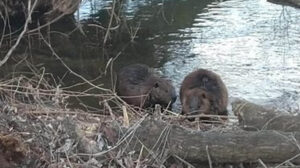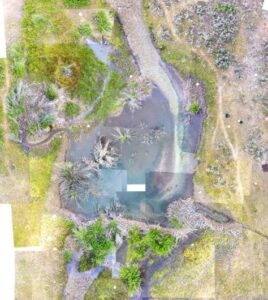Well, do I sound lighter? I’m officially cast free as of yesterday, Now I have a very heavy ski-like boot that I can remove to sleep. My foot is deeply terrifying to behold, a kind of Frankenfoot if you will, but I was thrilled to learn that the bones healed in all the right ways and now its just a matter of learning to do things with the boot so that some day I can have NO BOOT.
Good news on the beaver front also, two great stories that I cannot wait to share, the first from Idaho where they are starting to realize beavers are really cool. Shocking right?
Beavers are coming back and could bring benefits to ranchers and biodiversity in Idaho
 BOISE, Idaho (CBS2) — Beavers are making a comeback as a growing number of the critters are being reintroduced to landscapes, according to an article from Boise State University.
BOISE, Idaho (CBS2) — Beavers are making a comeback as a growing number of the critters are being reintroduced to landscapes, according to an article from Boise State University.
Jodi Brandt, an associate professor at Boise State University, researches issues vital to the Intermountain West, including urban growth, farmland preservation and water. In 2018, Brandt received a grant from the U.S. Department of Agriculture to use new satellite data to map water in semi-arid regions like Southern Idaho.
“Farmers and ranchers are always grappling with water scarcity,” said Brandt, an associate professor of human-environment systems in the College of Innovation and Design. As Brandt and Ph.D. student Nick Kolarik started their fieldwork, they spoke with farmers, ranchers and officials. An unexpected theme emerged: “beaver fever,” Brandt said.
Just remember that it took visionaries like Jay Wilde to be the test case for all the changes beavers could make in Idaho to improve ranchlands. Now every wants on the beaver bandwagon! Climb aboard, there’s plenty of room.
Brandt found people interested in, or already enlisting beavers to heal degraded terrain. Beaver dams hold water, creating habitat and mitigating drought. Beaver rewilding, or reintroducing beavers to landscapes, has gone on in the U.S., Europe and Canada for years.
California recently launched a major beaver restoration program at the urging of agricultural, tribal and business partners. Between 50 and 75 beaver rewilding projects are taking place in Idaho, Brandt said.
Well in theory, yes, Nothing much happening in practice.
These projects include reintroducing the animals in places where woody materials like cottonwoods and willows are available for dams, as well as “beaver mimicry,” or building dam-like structures that imitate beaver activity and, in some cases, encourage the animals to take up residency.
“We made the connection,” Brandt said. “We were mapping water on the landscape at the same time these beaver projects were changing how much water was there and when it was there.”
Still, bragging about beaver restoration is better than complaining about beaver damage. I have only good things to say about this article, and the cheerful webbed footprint it’s stamping on beaver habitat in Idaho.

Beaver ponds with deeper sediments store more nitrogen, simple mapping reveals
Beaver ponds contain nitrogen, an essential nutrient that can become a pollutant when too much is present. Land managers need to know if beaver ponds are storing or releasing nitrogen, but chemical testing can be expensive. A new study shows how simple mapping of a beaver pond’s depth and sediment can tell managers whether it’s a nitrogen source or sink.
The study was published in the Journal of Geophysical Research: Biogeosciences.
Nitrogen is used in synthetic fertilizers and is naturally found in manure, so grazing and agriculture have added nitrogen pollution to rivers in the U.S. West, causing eutrophication downstream. Previous studies have found that nitrogen can be either higher or lower downstream from beaver ponds. But few studies have closely examined what happens to nitrogen within a beaver pond, leaving open the question of whether beaver ponds tend to be good or bad for nitrogen pollution and whether beavers should be reintroduced to the ecosystem.
“It depends on the river, but for sites like the one we studied, reintroducing beavers could be a wise decision,” said Desneiges Murray, a biogeochemist who led the study while at Utah State University. (She is now at the University of New Hampshire.) “These ecosystems evolved with beavers in the first place. So, the combined effects of less erosion, better resistance to forest fires, more water storage during droughts, and now the benefit of long-term nitrogen storage— there are lots of reasons humans should be facilitating beaver recolonization into their natural habitats.”
Well, well. well. The chickens come home to roost I guess. Maybe those icky beavers can actually help your nitrogen polluted streams. Who knew?
 The new study maps zones within a beaver pond system, called a complex, nestled in the Bear River Mountains north of Salt Lake City. Murray and her co-authors defined five zones based on water flow, pond depth, and sediment thickness and grain size. They gathered data on how much nitrogen and oxygen were in the water in different zones, collected samples of pond sediments, and took long cores of sediment to analyze nutrient changes over time. Then they mapped it all, paying special attention to the ratio of sediment depth and water depth.
The new study maps zones within a beaver pond system, called a complex, nestled in the Bear River Mountains north of Salt Lake City. Murray and her co-authors defined five zones based on water flow, pond depth, and sediment thickness and grain size. They gathered data on how much nitrogen and oxygen were in the water in different zones, collected samples of pond sediments, and took long cores of sediment to analyze nutrient changes over time. Then they mapped it all, paying special attention to the ratio of sediment depth and water depth.
“This new approach of looking at geomorphic units within a beaver complex is going to be helpful for understanding why beavers reduced nitrogen, or heavy metals, or acid mine drainage,” said Emily Fairfax, a hydrologist and self-described “beaver-ologist, if that were a thing” at California State University-Channel Islands. Fairfax was not involved in the study.
Most nitrogen enters beaver ponds as dissolved and particulate nitrogen. Once in the pond’s sediments, nitrogen can go through chemical transformations into other forms, such as ammonium, inert nitrogen gas, or reactive nitrogen dioxide gas, which can degrade ozone in the atmosphere.
The researchers found the beaver pond was storing up to 15% of the nitrogen that came in, mostly in the sediments of the backwater zone. The backwater zone has thicker organic-rich sediments and the low oxygen concentrations necessary for nitrogen to convert to inert nitrogen gas, which can be stored. Other zones, with less sediment or more oxygen, weren’t able to store as much nitrogen. It’s the first such correlation between a beaver pond’s small-scale geomorphology and nitrogen, and it opens the door to new ways of assessing nutrients in beaver ponds.
A big takeaway for Murray is that mapping the zones of beaver ponds is a powerful tool on its own—land managers could skip the chemical analyses if they’re just looking for an estimate of nitrogen cycling. Ponds with thicker organic-rich sediments and shallow, low-oxygen water are more likely to store nitrogen; faster-moving ponds with more oxygen and less sediment are more likely to release nitrogen.
Huh, it;s almost like we NEED beavers! Who would have ever thought such a thing!
“Policies won’t change unless decision makers see local data,” Fairfax said. “I haven’t seen many studies on beavers’ impact on nutrient loads in the West, so this is a really valuable case study to add to the literature.”






































